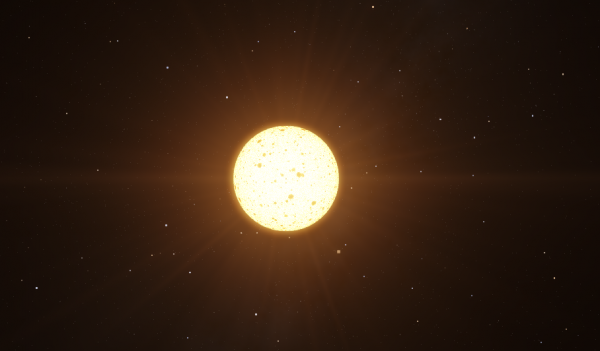BY LETTER
K-type Star
 Image from Steve Bowers |
The orange K type star is towards the dimmer and cooler end of the sequence of spectral types, although still hot and bright enough for any planets to be good candidates for colonization. These stars are distinguished by a strong metallic line, and molecular bands of CH and CN.
These stars are somewhat like Sol, although rather smaller and dimmer. The statistics for K type stars are given below:
| Class | Temp °K | Visual luminosity | mass x sol | radius x sol | Terrestrial Equivalent Orbit |
| K0 | 5250 | .34 | .790 | .786 | .65 AU |
| K1 | 5080 | .28 | .766 | .788 | .61 AU |
| K2 | 4900 | .21 | .742 | .750 | .54 AU |
| K3 | 4730 | .18 | .718 | .762 | .51 AU |
| K4 | 4590 | .12 | .694 | .692 | .43 AU |
| K5 | 4350 | 0.082 | .670 | .684 | .39 AU |
| K7 | 4060 | 0.042 | .606 | .641 | .32 AU |
While a K0 type star has a mass of about 0.8 times that of Sol, its visual luminosity is only about a third as much. The K5 spectral type is dimmer, its visual luminosity is less than a tenth that of Sol, but with a surface temperature of only 4350 K the star emits plenty of infra-red radiation.
But what they lack in brightness these stars make up in longevity; even the K0 type will spend some 17 billion years on the main sequence. And while these stars have a fairly small life-zone as far as terragen comfort goes, but cold-adapted life benefits, and Europan Type worlds and life may be common if conditions are favourable. Arean Type worlds are also very common, and these are always good candidates for terraforming. K-type solar systems are therefore quite popular among development corporations and colonists.
Related Articles
- A-Type Star
- Apparent Brightness of the Local Sun
- B-Type Star
- F-type Star
- G-Type Star
- M-Type Star
- O-type Star
- Spectral Class - Text by M. Alan Kazlev
A class to which a star belongs because of its spectrum, which in turn is determined by its temperature. The spectral classes are O, B, A, F, G, K, and M, from hottest to coolest.
Development Notes
Text by M. Alan Kazlev
Initially published on 25 November 2001.
Initially published on 25 November 2001.
Additional Information
Acknowledgements:
Table data from here
Star Tables by Gerald Nordley
Table data from here
Star Tables by Gerald Nordley






